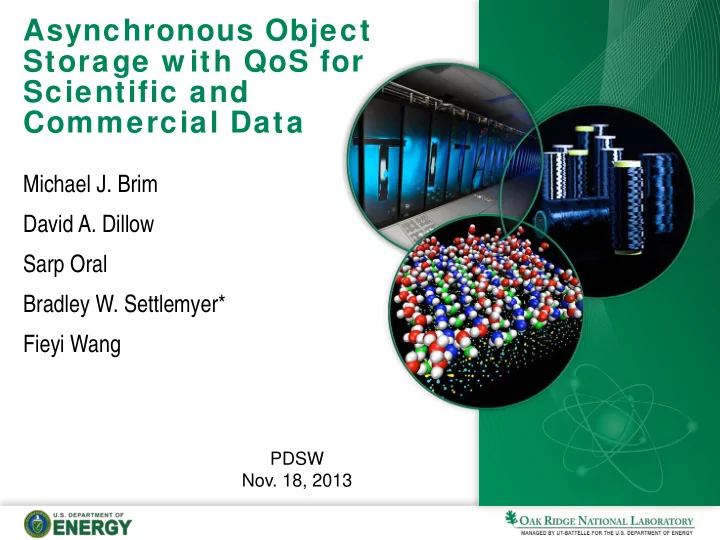

Asynchronous Object Storage w ith QoS for Scientific and Commercial Data Michael J. Brim David A. Dillow Sarp Oral Bradley W. Settlemyer* Fieyi Wang PDSW Nov. 18, 2013
Introduction “Scientific discovery in energy research and a wide range of other fields increasingly depends on effectively managing and searching large datasets for new insights.” - Dr. Steven Chu, Secretary of Energy Big Data Research Initiative, March 29, 2012 • What is Big Data – Volume, variety, and velocity – Good support for statistical inference/induction • As opposed to traditional descriptive statistics – Exposes some weaknesses in existing HPC storage systems 2 SOS: The Scalable Object Store
Big Data HPC Use Cases 1. Scientific Application Checkpointing – Codes often time-step based simulation – Bursty I/O (write for 5 minutes, once an hour) – Almost entirely storage system write limited – Large fraction of the memory space of the entire application streaming to storage 2. Big Data Analysis – Data mining, parallel data analysis, statistical induction – Ideally, Map-Reduce – Large block storage system reads – Almost continuous storage system load 3 SOS: The Scalable Object Store
Interference Scenario Compute Nodes Storage Nodes 4 SOS: The Scalable Object Store
Interference Scenario Science Simulation Storage Nodes 5 SOS: The Scalable Object Store
Interference Scenario Science Simulation Inferential Analysis Storage Nodes 6 SOS: The Scalable Object Store
Interference Scenario Science Simulation Inferential Analysis Read(fd1, buf, len); Read(fd2, buf, len); 7 SOS: The Scalable Object Store
Interference Scenario Science Simulation Inferential Analysis Write(fd, buf, len); Read(fd1, buf, len); Read(fd2, buf, len); 8 SOS: The Scalable Object Store
Interference Scenario Science Simulation Inferential Analysis Write(fd3, buf, len); Read(fd1, buf, len); Read(fd2, buf, len); 9 SOS: The Scalable Object Store
Interference Scenario Simulation Inferential Analysis Write(fd, buf, len); Read(fd1, buf, len); Read(fd2, buf, len); 10 SOS: The Scalable Object Store
I/O Interference Reality • Why can’t scientific applications just overlap computation with I/O? – A time-step based simulation doesn’t checkpoint after every time-step, just after some time-steps – Next program state depends on previous program state – Significant memory pressure – Coordination across multiple compute nodes makes these problems worse rather than better • Doesn’t CFQ scheduling make this a non-issue? – The storage servers use the same PID • Alternative solutions like ADIOS circumvent FS services 11 SOS: The Scalable Object Store
Read/Write I/O interference • Low-end storage array • High-end solid state storage (FusionIO Octal) • Simultaneous access falls off immediately • Performance loss due to large queue depths 12 SOS: The Scalable Object Store
A Scalable Object Store • HPC Storage + Analytics • SOS Goals: 1. 100% Asynchronous Variety Volume access 2. Provide storage quality of service (QoS) Big Data 3. Object resilience with multi-tiered storage 4. In transit object data Velocity transformation 13 SOS: The Scalable Object Store
Quality of Service • Two factors make QoS tractable: – SOS I/O is fundamentally async and server-directed – Object semantic takes away consistency between two clients writing to same store • Lot’s of existing work on how to do this for a single server with multiple clients – No magic, we just take a slotted approach to multiple access (like ALOHA) – Don’t try to make it perfect, if an IOP runs past the end of the slot, complete it anyway • Clients request QoS via reservations – Similar to network RSVP protocols 14 SOS: The Scalable Object Store
SOS Prototype Data Organization Model • Objects – Named data buffers • Object Collections – Lists – named collection of objects – Maps – named collections of lists • Provides naming hierarchy, that we believe is compatible with use cases 15 SOS: The Scalable Object Store
SOS Prototype Storage Organization Model • Object Lockers – A dynamically provisioned allocation of storage resources – Provides opaque private namespace – Returned via a reservation request – Lockers provide the QoS scheme • Prototype implementation is based on Ceph – Lockers provided by RADOS pools – Asynchronous Object Placement with CRUSH is weird – Leverage the lessons of POSIX AIO and Linux AIO 16 SOS: The Scalable Object Store
SOS Prototype 17 SOS: The Scalable Object Store
Ongoing work • Server-directed object placement – Ceph uses CRUSH which is client directed placement – Exploring organizing locker’s out of Chord Rings • Scalable reservation protocols – Currently dedicating a server interval slot to handling reservations – Simply dropping reservation requests when a reservation for a new locker cannot be satisfied – Reservations acquired in order for existing lockers (to avoid dining philosophers problem) – Fault tolerant runtimes are still rare 18 SOS: The Scalable Object Store
Future Use Cases • Scalable Fault Tolerance Backplane (for runtimes) – Storage systems are and should continue to be far more reliable than large compute resources • Visualization and performance traces – Tricky because these are user-guided, and performance is dominated by small, unaligned data access • Key-value support – Important to whole classes of Cloud applications – E.g. HTTP Session Data 19 SOS: The Scalable Object Store
Acknow ledgements Research sponsored by the Laboratory Directed Research and Development Program of Oak Ridge National Laboratory, managed by UT-Battelle, LLC, for the U. S. Department of Energy. This work also used resources at the Extreme Scale Systems Center, located at Oak Ridge National Laboratory and supported by DoD. 20 SOS: The Scalable Object Store
Thanks! Questions? 21 SOS: The Scalable Object Store
Asynchronous I/O Interfaces • HPC networks moving steadily toward asynchrony simply to support scale • Many existing asynchronous I/O API’s problematic • The only exception I am aware of is Linux AIO – Has proven very useful in scenarios such as FS scan – Effective because it improves disk access performance! • SOS attempts to build on lessons of Linux AIO – HPC networks likely natively async – Improve disk performance via server-directed I/O – Improve client predictability QoS 22 SOS: The Scalable Object Store
Recommend
More recommend